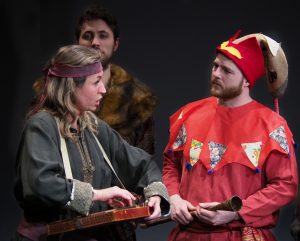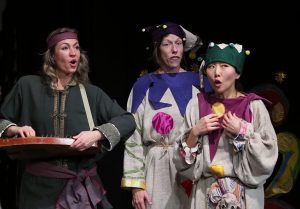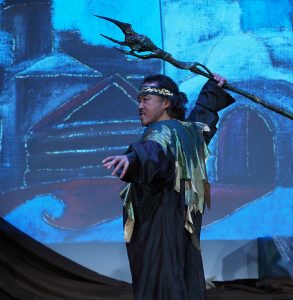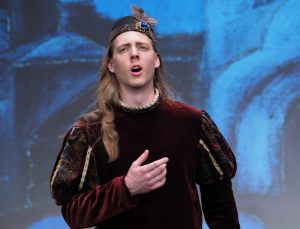This story features “Sadko” presented by Bel Cantanti Opera. Learn more about this performance and get tix on the event page here.
When mounting a grand opera, there are many details to work through, from recruiting singers and musicians and a conductor to creating sets, costumes and lighting. Bel Cantanti’s production of “Sadko” presented an additional, even greater, hurdle for the company to overcome.

The opera, which premiered in 1898 in Moscow, is rarely done, even in Russia. Its presence is even scarcer in the United States; the Bel Cantanti production marks only the second time an American company has presented it, the first time in Russian. New York’s Metropolitan Opera performed it in French in 1930.
The fairytale opera takes place during the 12th century in the Russian city of Novgorod, a place that had early democratic tendencies at a time when Christianity first came to the country and there were vestiges of paganism, said Katerina Souvorova, Bel Cantanti’s artistic director who also acts as producer and conductor of “Sadko.”
Sadko, a young gusli player (gusli is a Russian multi-string plucked instrument) travels around the world in search of trade, but instead finds love, wisdom, magic and truth along the way. Tenor Patrick Cook sings the title role.
Bel Cantanti was determined to produce the opera, considered a giant among the works of Nikolai Rimsky-Korsakov, one of Russia’s most beloved composers, according to Souvorova. But there was that hurdle: An orchestral score of “Sadko” was extremely hard to find, although “we searched far and wide,” said mezzo soprano Viktoriya Vita Koreneva, who sings the role of Lyubava, Sadko’s long-suffering wife.

Souvorova was ready to give up and use only piano accompaniment for the opera– which would have been a less-than-ideal solution, considering that Rimsky-Korsakov is known for his brilliant orchestrations.
But Koreneva, who lives in New York City, knows someone who led her to the only copy of the orchestral score that could be found — at the Lincoln Center Library for the Performing Arts. Since the 570-page score was too fragile to be photocopied, it had to be photographed, page by individual page, then transcribed into individual orchestral parts by pianist and conductor Francisco Miranda.
There was one more, albeit less daunting, challenge: the opera is being sung in the original Russian with English supertitles by a cast that is mostly American. But practice, and the helpful presence of cast members who are Russian natives or speakers, did the trick. Souvorova herself is Russian-born.
What drew her to this opera, so little known and certainly a contrast to the wildly popular “The Magic Flute,” which was Bel Cantanti’s previous production? “It’s the best opera Rimsky-Korsakov ever wrote,” Souvorova said. “The music is amazing, but it wasn’t even that. It’s also the story. ‘Sadko’ is not a typical opera, which is usually a love story. Either the couple breaks up or gets married.”
There is a love story, she acknowledged, yet it is not central to the plot. Sadko, the musician hero, is married, yet he falls in love with the Sea King’s daughter (soprano Katie Manukyan), who returns his feelings — in large measure because of his musical ability. Realizing their situation is hopeless — in a manner reminiscent of “The Little Mermaid” in the original Hans Christian Andersen story (not the Disney movie) — she dissolves into the sea.

“Sadko,” an opera in seven scenes based on Russian ballads, includes an underwater kingdom, Souvorova said. “There are beautiful costumes and scenery. The opera is fully staged.”
Dance is often a component of grand opera, and “Sadko” is no exception. Two area dance companies have become regular collaborators with the Silver Spring-based opera company, and both are participating in this production. “I believe in mixed-media presentations,” said Souvorova. “They love us, and we work well together.”
The two dance companies divide the labor in this opera, with the Four Seasons Dancers portraying “real people,” in Souvorova’s words, and The Olney Ballet company dancers taking on the roles of the magical underwater creatures.
The response of cast members confirmed the artistic director’s choice of opera. “‘Sadko’ is absolutely wonderful,” said Koreneva. “It’s an interesting story and a wonderful score, and it’s exciting that we’re singing it in the original Russian.”
Koreneva often has used one of the “Sadko” arias at auditions, and people would always exclaim how “gorgeous” the music is, she said.

Despite its fairytale nature, “Sadko” has some underlying historical and cultural themes. “Because of the highly patriarchal nature of Novgorod, a man meant everything, and it was devastating for Sadko’s wife when he leaves her– even if it was for business reasons,” Koreneva added. “When he returns, he’s very wealthy, but the important thing for Lyubava is that he’s back. She’s no longer stigmatized for living alone.
“Sadko” is also about the people of the city, who are “forward thinking in their attempt to find a link between their lake and the sea and to connect with the world,” said Souvorova.
Despite her huge admiration for the work and her excitement at being only the second presenter of “Sadko” in the United States, Bel Cantanti’s artistic director has made two changes to the opera. One is reducing its length from a potentially onerous just-under-four-hours to about two-and-a-half. The other is reducing the size of choral parts, which accounts for many of the time reductions as well. “The original opera required like 50 singers in the chorus,” she said.
No chance that the stage will be bare, however. The opera has a cast of some 15 singers, an 11-member orchestra as well as the dancers.
Bel Cantanti‘s “Sadko” will take the stage at 7:30 p.m. Friday, March 23, and 3 p.m. Sunday, March 25, at the the Randolph Road Theatre, 4010 Randolph Road, Silver Spring. Tickets–$40, $35 for seniors, $15 for students—are available online through www.eventbrite.com and at the door. For information, call 240-230-7372 or visit www.belcantanti.com.